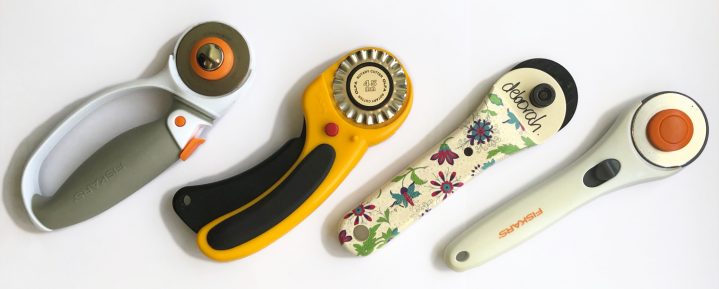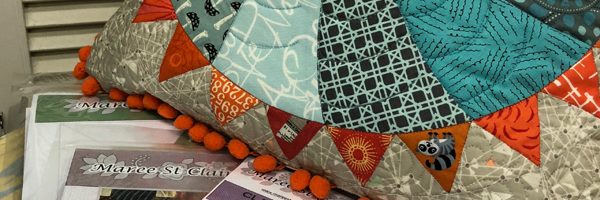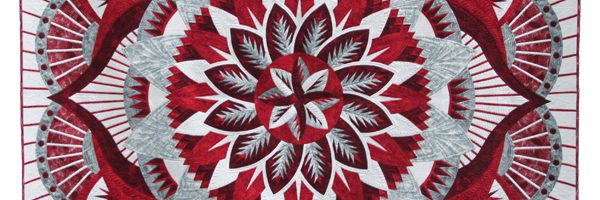
Know Your Product: Rotary Cutters
By Deborah Segaert
There are numerous rotary cutter brands on the market. Twenty years ago, my first rotary cutter was an Olfa. Since then, Fiskars and Clover have embraced the quilting market and, more recently, a number of smaller manufacturers have started offering these products.
I have added a number to my tool collection over the years, including the Olfa Exclusives Calantha Plum (the only reason why I ‘needed’ this one was because it’s pretty!) and an Olfa Ergonomic. You will notice that I have the pinking blade attached — this allows me to cut shapes that won’t fray. I also own a straight stick Fiskars and a Fiskars Titanium Softgrip® Comfort Loop Rotary Cutter.
While all I expect from my cutter is to cut, and therefore the blade is important, the most significant attribute a rotary cutter can have is the comfort and ease of use. Due to the repetitive nature of cutting fabrics with a rotary blade, it is important that you choose a cutter than you find comfortable to use. The shape and style of the handle are the key factors.
You need to look for the right combination of comfort, convenience, strength and safety that suits you personally. Ergonomic handles with anti-slip rubber grips eliminate hand fatigue and stress, while a squeeze trigger allows the blade to self-retract for safety. Cutters without a squeeze trigger can easily engage or retract the blade with a push lever.
Blade handle
As you will be gripping your rotary cutter for a length of time, you want to be sure the handle is comfortable to hold at the angle you will use the tool. Visit your local quilt and craft shop and actually hold the blades in your hand and use them to determine which fit is most comfortable. There are some handles specifically designed with people with arthritis and grip issues in mind, so keep an eye out for these if this is an issue for you.
In all instances it is easier and safer to cut when in a standing position. Depending on the handle style, you will need to hold the cutter in a certain manner — either quilt upright (for a stick handle) or in a lower position more parallel to the cutting surface.
Blade diameter
Blades are available in 18mm, 24mm, 45mm and 60mm diameter. The larger the blade, the more fabric you can cut at once. However, larger blades can be less easy to manage. Likewise, the smaller blade is easier to handle and manoeuvre on small, intricate shapes. Just like in the Goldilocks story, the middle-sized blade is the most suitable as an all-purpose blade.
Blade material
A good blade saves you time by allowing you to cut through up to six layers of fabric in one pass; it also saves energy if you don’t have to struggle with an inferior or blunt blade. A superior blade, made of tungsten or carbon steel, will last longer. When your blade becomes blunt it will cause your fabric to catch or snag on any tiny burrs. It will also fail to cut cleanly through the fabric layers and require more pressure with less accuracy.
Create a fun, scrappy bag with patches and lots of embellishment
Safety latches
Most rotary cutters have a safety latch that moves back and forth to either expose the blade or cover it. Some will be more difficult to manage if you have carpal tunnel syndrome, arthritis, or another condition that results in weakened hands or wrists. Several manufacturers make rotary cutters with automatic closures.
Try out several cutters to discover which have safety devices that are easiest for you to manipulate. Some quilt shops have rotary cutters set up on a cutting board, or maybe you can try your friend’s? You will be opening and closing the latch constantly as you work, so ease of use is critical. There are also cutters that self-open on pressure and snap closed when done.
How to use your rotary cutter
Once you have decided which rotary cutter suits you best, you will need a cutting mat (see the previous issue) and a ruler (see the next issue), then you will be ready to learn to use these three tools simultaneously. Rotary cutting is one of the most time-saving skills a quilter can master because it eliminates the need to mark and cut individual patches of fabric. Not only does rotary cutting speed up quilt assembly, if done correctly it will most definitely enhance your accuracy.
Where to buy rotary cutters
All quilting, sewing and crafts shops are likely to sell rotary cutters. Check with your local store and/or those businesses that advertise in Quilters Companion. A few of our advertisers are manufacturers and/or distributors of well-known brands, and shop owners can purchase from these.
Make a captivating traditional scrap quilt with this pattern
Fiskars
Fiskars offers highly durable titanium or stainless-steel rotary cutters. Various units feature various-sized blades, from 18mm to 60mm diameter.
Right- and left-handed users can use most of the units as the blade can be assembled on either side. You’ll have optimal viewing space of the blade at all times, allowing you to confidently cut through even the thickest of fabrics.
Fiskars provides a sliding button to extend or retract the unit’s blade for added safety when in storage or during use. You can assemble the blade on either side, and this model features a stainless-steel blade rather than a titanium-coated blade.
The loop handle unit improves the user’s control when handling the rotary cutter, and the ergonomic design adds to the comfort of the tool.
All Fiskars rotary cutters come with a standard lifetime warranty, so your investment is always safe when choosing cutters from this manufacturer.
Distributed in Australia by Fiskars Australia. For more information visit www.fiskars.com.au
TrueCut
The TrueCut My Comfort cutter is an ergonomic rotary cutter that eliminates stress in the wrist and arm and can be used right- or left-handed. This unit features a unique handle design that aligns your wrist naturally (placing all cutting power directly over the blade). The safety guard is easy to use and the Removable Cutter Guide can be removed for normal use with any ruler (without track guide feature).
The handle insert is removable, allowing you to customise your cutter with your own designs, photos or fabric!
Distributed in Australia by Know How Sewing Essentials. For more information visit www.knowhowsewing.com.au
Create Samantha Green’s Daydream exploded-hexi quilted cushion
Clover
The soft-cushioned handle of the straight-stick Clover cutters can be used upright or at an angle. They can be adjusted for left- or right-handed use, and are available in four sizes: 18mm, 28mm, 45mm and 60mm. The blades are sold separately.
The units include the safety lever that can be pulled down to expose the blade and pushed back to cover.
Clover cutters are manufactured in Japan and distributed in Australia by QH Textiles. For more information visit www.qhtextiles.com




